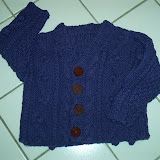Knit Pig
From Wikipedia:
Pigs are ungulates native to Eurasia collectively grouped under the genus Sus within the Suidae family. They have been domesticated and raised as livestock by some peoples for meat (called pork) as well as for leather. Their bristly hairs are also traditionally used for brushes. Wild pigs continue to fill these functions in certain parts of the world.
Pigs are omnivores, which means that they are easy to raise. On a small farm, or in a large household, they can be fed kitchen scraps as part or all of their diet. In the wild, they are foraging animals. Pigs that are allowed to forage may be watched by swineherds. Because of their foraging abilities and excellent sense of smell, they are used to find truffles in many European countries. They are also fattened to be eaten as ham and other types of meat.
Pigs are one of the most intelligent mammals, and some, such as the Asian pot-bellied pig, are kept as pets. Pigs are reportedly more intelligent and more trainable than dogs and cats.
A litter of piglets typically contains between 10 and 12 animals. Occasionally, in captivity, pigs may eat their own young.
Pigs lack sweat glands. Thus they must have access to water or mud to cool themselves during hot weather. They also use mud as a form of sunscreen to protect their skin from sunburn.
Knitting is one of several ways to turn thread or yarn into cloth (compare to weaving, crochet). Unlike woven fabric, knitted fabric consists entirely of horizontal parallel courses of yarn. The courses are joined to each other by interlocking loops in which a short loop of one course of yarn is wrapped over the bight of another course. Knitting can be done either by hand, described below, or by machine. In practice, hand knitting is usually begun (or "cast on") by forming a base series of twisted loops of yarn on a knitting needle. A second knitting needle is then used to reach through each loop (or stitch) in succession in order to snag a bight of yarn and pull a length back through the loop. This forms a new stitch. Work can proceed in the round (circular knitting) or by going back and forth in rows. Knitting can also be done by machines, which use a different mechanical system to produce nearly identical results.
Originally a male-only occupation, the first knitting trade guild was started in Paris in 1527. Knitting became a household occupation with the growing popularity of knitted stockings and by the end of the 1600s, one to two million pairs of stockings were exported from Britain to other parts of Europe.
Put the two together- what do you have?

Yes Chris, it's a toy.
PS- I stole this picture from jamby on the crafster.com forums. I only hope mine wull look this good!








<< Home